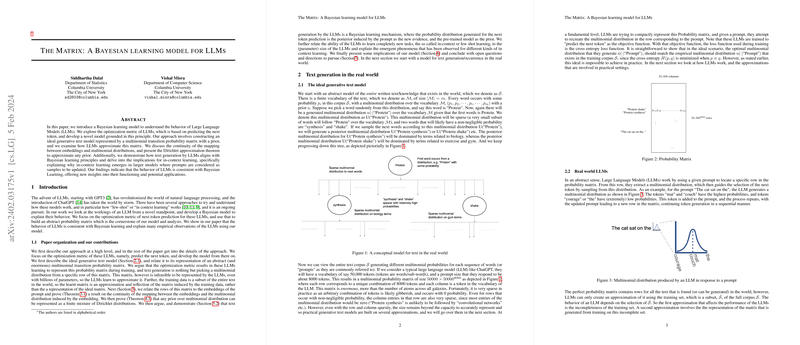Unveiling the Bayesian Foundations of LLMs through "The Matrix"
Exploring the Bayesian Learning Model
The recently introduced paper explores a novel Bayesian learning model tailored to comprehend the inner workings of LLMs. By constructing an abstract multinomial transition probability matrix with priors, the paper aims to investigate how LLMs approximate such matrices and how this approximation aids in text generation. This approach offers intriguing insights into the continuity of mappings to approximate priors and the emergence of in-context learning in larger models.
Model Construction and Insights
The authors begin by detailing how LLMs, including notable examples like GPT3 and ChatGPT, revolutionize natural language processing through their optimization for next-token prediction. The core concept revolves around an (idealized yet unfeasible) gigantic multinomial transition probability matrix that LLMs learn to approximate. This theoretical matrix, representative of all possible text generations, forms the basis of the Bayesian learning model introduced in the paper.
The Ideal and the Real
The juxtaposition of an ideal generative text model against the constraints of real-world LLMs forms a significant discussion point. The authors outline how the practical limitations and approximations inherent in LLM design influence their ability to mirror the theoretical model. This examination sheds light on the nuances of text input conversion to embeddings, the subsequent generation of multinomial distributions, and the iterative nature of this process in text generation.
Bayesian Learning as a Cornerstone
Central to the paper is the assertion that the mechanics of text generation by LLMs align with Bayesian learning principles. According to the authors, the combination of prior distributions (based on pre-training) and new evidence (presented by prompts) underpins the generation of posterior multinomial distributions. This Bayesian updating mechanism, pivotal for text generation, is substantiated through various mathematical formulations, including a proof demonstrating continuity in the embeddings-to-distributions mapping.
Towards Understanding In-context Learning
A notable application of the Bayesian model is its elucidation of in-context learning phenomena observed in LLMs. The research delineates how the observed adaptability of LLMs to new tasks through few-shot or in-context learning can be interpreted through the lens of Bayesian inference. By analogy, the behavior of LLMs across different paradigms of in-context learning, including semantically unrelated in-context learning, is analyzed, showing remarkable alignment with Bayesian learning processes.
Practical Implications and Theoretical Contributions
The explored Bayesian model not only clarifies the mechanism behind in-context learning but also provides a foundational perspective on several aspects of LLM operation:
- Embeddings and Approximations: Emphasizing the role of embeddings, the paper underscores their significance in bridging the gap between abstract models and practical LLM implementations.
- Dirichlet Approximation: Through mathematical rigor, it's demonstrated that any prior over multinomial distributions approximates as a finite mixture of Dirichlet distributions, potentially guiding the optimization of LLM training sets.
- Generative Mechanisms and Learning Efficiency: The delineation of text generation as a Bayesian learning procedure hints at ways to enhance LLM efficiency, particularly in adapting to new evidence or tasks.
Future Directions and Concluding Thoughts
Wrapping up, the paper not only enhances our understanding of LLMs through a Bayesian prism but also opens several avenues for future research. From investigating the implications of large context sizes to unraveling the exact impact of parameter size on in-context learning, the exhaustive analysis provided here lays a robust foundation for dissecting the complex behaviors of LLMs.
Moreover, while the implications of these findings are broad and far-reaching, the authors caution against overestimating the readiness of the proposed model to solve all of LLMs' enigmas. The proposed Bayesian learning model constitutes a significant step forward in decoding the structured yet elusive architecture of LLMs, advocating for a continued, nuanced exploration of generative AI.
